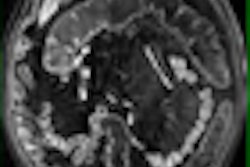MRI may help guide orthopedic treatment planning by identifying meniscal tears that are likely to become unstable and develop into bucket handle tear pathology.
In a study presented at the 2008 RSNA meeting in Chicago, researchers from Thomas Jefferson University Hospital in Philadelphia found that vertically oriented medial meniscal tears involving both articular surfaces, the posterior horn, and the red zone may predispose individuals to a future medial meniscal bucket handle tear.
The researchers performed a database search for all MRI reports with a bucket handle tear from 1999 to 2005. The query generated 468 MRI reports, and this group was retrospectively reviewed for prior MRI reports that did not demonstrate a bucket handle tear. Using that criterion, the sample was whittled to 17 patients.
Thirty-four initial and follow-up knee MRI exams were then retrospectively evaluated for the 17 patients, who had an initial MRI that did not demonstrate a medial meniscal bucket handle tear and a follow-up MRI that did.
MRI reports
"The initial exams were re-reviewed for the presence of an [anterior cruciate ligament (ACL)] or any other ligament injury prior to ACL reconstruction and the presence of a medial meniscal tear," said Dr. Adeel Azam, who presented the findings at the annual RSNA 2008 meeting. "For patients with a medial meniscal tear, the initial MRI was made up of the type of meniscal tear, the medial meniscal articular surfaces involved, the tear location, and the zone of tear."
Of the 17 patients, it was found that 12 cases had ACL pathology on the initial exam, nine patients had an ACL tear, and three patients had a preceding ACL reconstruction.
The researchers also found 16 patients with a preceding medial meniscal tear. "Of those 16 patients with medical meniscal tears not found on MRI, three were complex, nine were vertical, two were oblique, and two were radial," Azam added.
Data analysis
In a further breakdown of the data, the researchers found eight (47%) knees with medial meniscal bucket handle tears that also had an ACL tear on the initial exam. Three (18%) knees had a preceding ACL reconstruction and 16 (94%) had a preceding medial meniscal tear.
All 16 of the preceding medial meniscal tears involved both articular surfaces and the posterior horn, three tears (19%) also involved the body, and there were no cases involving the anterior horn.
Five (31%) of the preceding medial meniscal tears were in the white zone, whereas four tears (25%) were located in the pink zone and 12 (75%) were in the red zone. Nine (56%) bucket handle tears demonstrated a preceding vertical medial meniscal tear involving both articular surfaces, the posterior horn, and the red zone on the initial exam.
"In conclusion, MRI may help guide orthopedic treatment plans by identifying meniscal tears that are likely to become unstable and develop into bucket handle tear pathology," Azam said.
Knee treatment
The researchers also recommended considering primary care of vertical meniscal tears that extend to both articular surfaces and the posterior horn and red zone. Currently, conservative treatment is most commonly used for vertical medial meniscal tears.
Azam said the researchers hope their findings will help their orthopedics colleagues consider surgical meniscal repair before a bucket handle tear develops and "find a new standard of care in the treatment of peripheral, vertical, and medial meniscal tears."
By Wayne Forrest
AuntMinnie.com staff writer
January 26, 2009
Related Reading
Greatest pain comes four hours after MR arthrogram injection, December 26, 2008
MR arthrography outdoes 3-tesla MR on tendon tears, December 12, 2008
MR arthrography study finds 'optimal injection site,' October 24, 2008
Making the most of MRI to assess the rotator cuff pre- and postinjury, November 9, 2007
MRI keeps pace with rapidly evolving musculoskeletal systems of young athletes, May 20, 2007
Copyright © 2009 AuntMinnie.com



.fFmgij6Hin.png?auto=compress%2Cformat&fit=crop&h=100&q=70&w=100)




.fFmgij6Hin.png?auto=compress%2Cformat&fit=crop&h=167&q=70&w=250)











